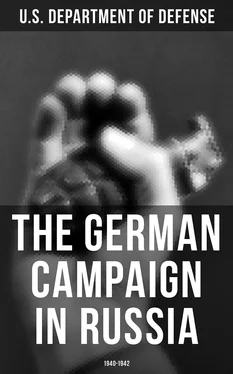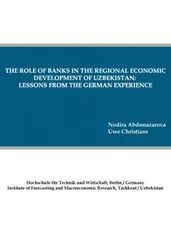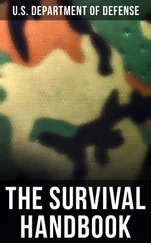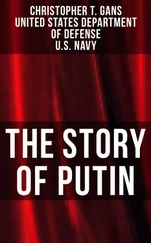The German Army would have to concentrate its forces in the northern part of the theater, crush all opposition, and capture Moscow. To this end it would build up its main effort between Brest Litovsk and Gumbinnen and advance first toward the line Rogachev — Vitebsk. Weaker German forces assembled between Jasi and Jaroslav, south of the Pripyat, were to attack in the direction of Kiev and the Dnepr southeast of that city. They would thus forestall a Russian offensive on Romania and form the southern arm of a pincers that would be closed east of the upper Dnepr. To the north of the main effort, a secondary attack force would thrust across the Baltic States toward Leningrad and seize the Russian naval bases.
1. The Offensive in the South. An attack against the Russian forces in the Ukraine would have to be launched to protect the Romanian oil fields. If the main effort could have been made from Romania and secondary thrusts from northeastern Hungary and southeastern Poland, this operation might have become the principal attack across the Dnepr toward Moscow. But neither the political situation in the Balkans nor the road and rail nets in Hungary and Romania would permit the assembly of the necessary forces prior to the tentative date set for the launching of the campaign. A thrust from southeastern Poland in the direction of Kiev and the middle Dnepr, though quite feasible, could not possibly be made the principal operation because the maneuvering space was too narrow and the distance to Moscow too great.
This southern thrust, however, would have to be executed with sufficiently strong forces to destroy the Russians in the western Ukraine and gain the east bank of the Dnepr. Any further advance would have to be coordinated with the principal operation in the northern part of the theater and could be conducted either due eastward toward Kharkov or northeastward. In any event, the main effort of the offensive in the south would have to be on the left, with Kiev the principal objective. A secondary attack force, jumping off from Romanian territory, could link up with the main-effort grouping along the middle Dnepr. Three major roads would be available for the advance toward the river line between Dnepropetrovsk and Cherkassy. The Romanian Army could participate in the occupation of Bessarabia, Odessa, and the Crimea.
2. The Main Effort. The main effort was to lead to the destruction of the Russian forces west of Moscow by a direct thrust on the capital. Once in possession of Moscow and northern Russia, elements of the main-attack force would turn south and seize the Ukraine in conjunction with the southern groups.
The principal attack would have to be directed from East Prussia and the northern part of Poland toward Moscow because no decisive operation could be launched from Romania and an initial sweep toward Leningrad would only lengthen the distance to be covered and lead into the dense forests northwest of Moscow.
During the advance on Moscow the left flank would be protected by a special force that was to be committed across the Dvina River toward Pskov and Leningrad. After capturing the latter important industrial city this force might operate in conjunction with the main-attack force.
The road and rail nets west of the Russian border were capable of supporting the advance on Moscow. The terrain that had to be crossed by the forces jumping off from East Prussia was difficult. They would have to traverse a forest and lake belt between the Dvina and Dnepr. There, the battle for the traffic arteries would be decisive. Airborne troops would have to take possession of the eastern exits from large forest areas and thus keep the roads open.
3. Movements. Since surprise and speed were of the essence, armored and motorized infantry forces supported by tactical air power were to break through the enemy lines, with ordinary infantry divisions following closely to encircle and destroy the isolated enemy forces. The strength of the first attack wave was limited by the relatively small number of through roads. At most, two division-size units could advance abreast on any one road. The bulk of the infantry with its horse-drawn vehicles would have to march on such side roads as were available. As a result, all units would have to be deployed in great depth. The enormous width of the funnel-shaped theater necessitated keeping strong motorized forces in reserve and so distributing them that they could easily be shifted within the theater.
g. Distribution of German Forces.
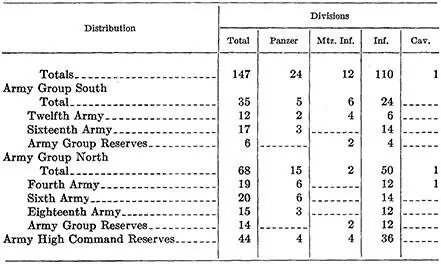
h. Primary Missions of the Ground Forces. The primary mission of Army Group South was to destroy the Russians in the western Ukraine and to establish bridgeheads across the Dnepr from which the army group forces could continue eastward or northeastward.
Army Group North was to seize Moscow. To accomplish this, motorized units would have to drive through the forest areas between Rogachev and Vitebsk with airborne troops assisting them at the forest edges. If the Russians chose to make a stand between the jump-off line and the forests or the Dvina, they would have to be pushed northward, away from the direct route to Moscow. While the reduction of these enemy forces was under way, the armored and motorized units were to move on until they reached the Russian capital.
i. The Mission of the Air Force. The Luftwaffe was to neutralize the Soviet Air Force, disrupt rail and road communications, prevent the concentration of Russian ground forces in the forests areas, support the German spearhead units with dive-bomber attacks, prepare airborne operations, and secure the air above traffic bottlenecks.
j. The Mission of the Navy. The Navy was to neutralize the Russian fleet in the Baltic, safeguard the iron ore shipments from Sweden, and transport supplies across the Baltic as soon as the Army had seized the ports.
k. Logistics. A special staff was to be formed to coordinate supply problems and establish bases behind the two army groups. It was anticipated that the Russians would attempt to carry out large-scale demolitions and destroy supply dumps, rail lines, and bridges. This could be partially prevented by keeping them off balance and by preparing appropriate countermeasures. In the Ukraine, Lithuania, and Latvia agents might be able to seize bridges and railroad installations and thus prevent their destruction. All railroad tracks beyond the former Polish border would have to be converted from the Russian wide to normal gauge.
A military administration would have to be set up for the occupied areas. In the Baltic States, White Russia, and the Ukraine the military government agencies would have to work toward turning their authority over to autonomous, non-Communist local governments.
l. Time Phasing. The most favorable season for the campaign was from mid-May to mid-October. After a mild winter, it might be possible to start as early as the beginning of May.
It was anticipated that all units needed for the initial operations would be assembled before the outbreak of hostilities. In the event of an unexpected outbreak of fighting, the forces scheduled to be assembled in the Army Group North area would need approximately 10 days to arrive in their designated areas and those in the south 9 days.
During the initial phase of the German offensive the Russians would probably fight delaying actions over distances of up to 250 miles, until they reached their prepared positions. The German infantry divisions would take three weeks to cover this distance. The panzer divisions would have to advance so rapidly and penetrate so deeply that the Russians would be unable to man a continuous defense line. The issue of the entire campaign would depend on the success of the armored thrusts.
Читать дальше
